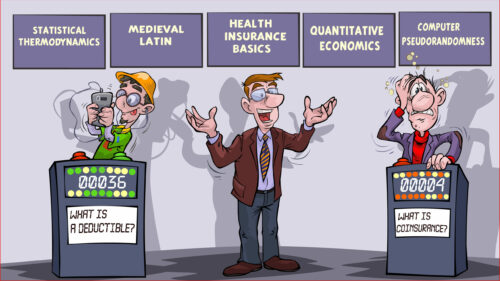President Trump infamously stated, “Nobody knew healthcare could be so complicated.” It turns out, there are a number of sources who can confirm healthcare complexity.
President Trump obviously didn’t speak, for example, with the simplicity experts at Siegel+Gale before making this statement — or before the multiple failed attempts to “repeal and replace” Obamacare. Health insurance in the United States has been ranked as the most complicated consumer experience in the world by Siegel+Gale in their Global Brand Simplicity Index. And, this top complexity ranking isn’t just one year. Health insurance in the U.S. has owned the bottom position each and every year since the annual ranking began in 2010.
Sadly, this complexity leads to consumer dissatisfaction. The maybe-not-so-scientific opinion researchers at Family Feud have provided proof. I was walking through the living room recently when my wife was watching one of her favorite shows, Family Feud. I heard host Steve Harvey ask, “On a scale of 1 to 10, how satisfied are you with your health insurance?” The number one answer was “1.” It sounds like people were feuding with the health insurance provider!
A more scientific survey methodology delivers similar findings. The folks at the American Customer Satisfaction Index had the following to say about health insurance in the financial services sector: “Health insurance is, by far, the most problematic and least satisfying category in the sector, in part because it is also the most complicated and controversial.”
PolicyGenius and Radius Global Research conducted a survey to determine how many people understood and could define the four key terms in health insurance — deductible, coinsurance, co-pay, and out-of-pocket. Co-pay was the most accurately defined term, with 52 percent of the respondents accurately defining it. Only 4 percent of respondents were able to accurately define all four terms! This may be even more shocking when you realize that 9 percent of Americans are employed in healthcare.
Gallup is also reporting dissatisfaction with the U.S. healthcare system. According to Gallup, “Seventy percent of Americans describe the current U.S. healthcare system as being ‘in a state of crisis’ or having ‘major problems.’ ”
The same report showed that 84 percent of Democrat or Democrat-leaning respondents felt the U.S. healthcare system was in a state of crisis or had major problems. This polling response provides strong insight as to why healthcare is a powerful political tool.
Surprise bills may be the No. 1 complexity villain and have recently become the subject of media scorn. A surprise medical bill occurs when an individual believes they’re accessing medical services from an in-network medical provider only to discover that some expenses are considered out-of-network or not covered at all. The unfortunate acronym, RAPERs — which stands for radiologists, anesthesiologists, pathologists, and emergency room physicians — have been among the most common drivers of surprise bills. These physicians sometimes choose to not join health insurance networks, even though they may be providing services within an in-network facility. The patient often doesn’t have a choice among these providers and often never meets or sees them. They become aware of their out-of-network presence when they receive the bill.
A few years ago, I was working with a city as their benefits consultant. They had an insurance committee with employees from different departments. The fire department representative on the committee was scheduled for knee surgery. He became aware of the surprise billing problem through committee discussions. Prior to going to the hospital for surgery, he wrote, “Cigna Doctors Only,” on his leg with a Sharpie. Much to his dismay, he subsequently received a surprise bill from a treating physician who was not contracted with Cigna.
Another common billing surprise situation comes from an emergency room or urgent care visit. Many plans include a fixed co-pay, such as $250, for an emergency room visit. This co-pay covers the emergency room facility charges. However, in many plans, it doesn’t cover the services of an emergency room physician. To make matters worse, this ER physician may not contract as an in-network provider, so the patient ends up with a surprise physician bill that was not covered by the emergency room co-pay, and this unexpected bill might not even include an in-network discount.
The complexity in healthcare creates a perfect environment for unpleasant surprises, which leads to consumer/voter dissatisfaction. This level of consumer dissatisfaction creates political opportunity. In spite of President Obama’s “if you like your plan, you can keep it” promise, Americans are increasingly hoping for something better. The right answer to our healthcare reform question is one that simplifies healthcare and health insurance and eliminates the unpleasant consumer surprises.
With that said, tune in next week where we’ll take a look at if we really do have the worst-performing healthcare system in the world. And, if you haven’t already, I encourage you to sign up for our “Insiders’ Club” where you’ll be notified when I release new information AND receive a FREE copy of my book “The Voter’s Guide to Healthcare: A non-partisan, candid, and relevant look at politics and healthcare in America” when it’s available.







